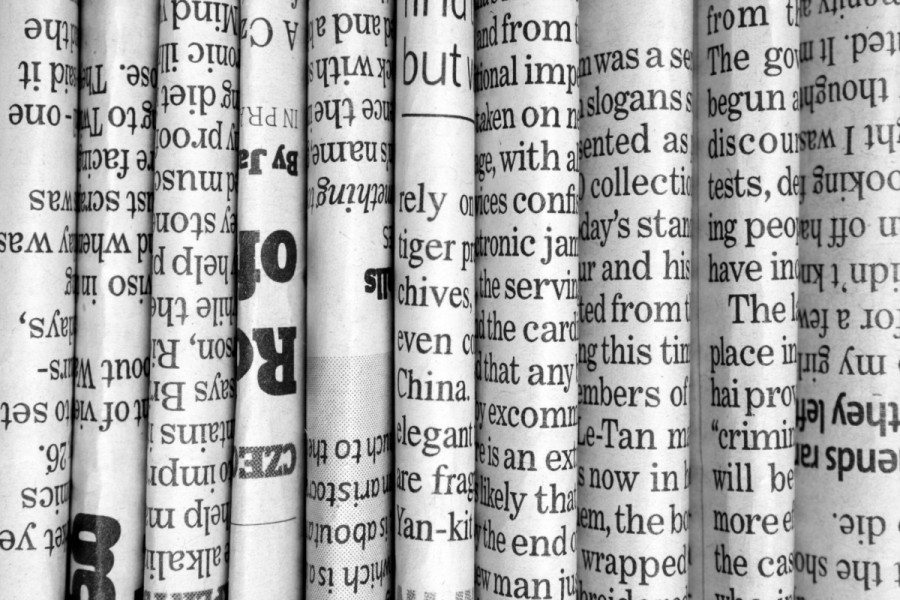Columns
Language in Nepal’s English press
The charm of English in journalism is real. What remains less discussed is the quality of English.
Dharma Adhikari
Kathmandu is widely recognised and frequently criticised for its surplus of newspapers, at least in the number of banners produced, if not in circulation. Even the city’s English-language newspapers defy demographic norms, with four broadsheet English dailies, albeit some have recently reduced page counts due to the pandemic and the surge in digital media. Additionally, there are a number of weeklies in English. Numerous online news portals find it fashionable to include an English-language section on their websites.
The charm of English in journalism is real. What remains less discussed is the quality of “English” used in these English-language outlets.
Widespread use
While it is generally agreed that the English language made its way into Nepal with the establishment of Durbar High School in 1853-54 for the Rana elites, it was not until a century later that any English-language media emerged. The monthly Nepal Guardian (1953-54), followed by the daily Motherland (1958-90), the weekly Nepalese Perspective (1964-75), and daily The Rising Nepal (1965-), among others, set the foundation of the English-language media in the country.
English language usage in Nepal has evolved significantly over the years. In 1996, Yugeshwar Verma, an English professor at Tribhuvan University, observed that English was already “pervasive” and that 25 percent of news dailies in the country were in English. A year later, David Crystal wrote in his book English as a Global Language that more than a third of residents in Nepal spoke English. Verma pointed out that English dominated the media, being the sole language, aside from Nepali. By the mid-2000s, a growing number of English-medium schools and FM stations were contributing to a noticeable rise in English usage among the youth. By then, English had already occupied a prominent position in sectors such as tourism, trade and business, international affairs, development, private education, media, and science and technology.
While Nepali remained the primary language in Nepal’s print press, by 2011, about 20 indigenous language newspapers, mainly in Newari, Maithili, Bhojpuri and Hindi, were published in the country. One reason why English content in media has become widespread is because Nepal is receptive to foreign programming. A study by Japanese professor Akinori Seki found that compared to Japan, Nepal had a higher popularity of non-native programmes, with most radio stations and TV channels broadcasting news and other programmes in English. Today, English has become one of the dominant languages in print, electronic and broadcast media, including FM radio stations and advertising. The youth, especially in urban areas, have ready access to English.
Nepali deviations
Despite the expanded access to English in the media, concerns about the quality of its usage remain. Verma observed that linguistic and sociocultural factors related to the writer cause deviations from standard English usage. English texts prepared for Nepal’s media are often translations of materials originally collected or written in Nepali, resulting in the persistence of “Nepaliness” in the use of non-English lexical items, transfer of Nepali grammatical structures, and the influence of Nepali stylistic conventions.
Critics view Nepal’s English press as adolescent and far from mature in language usage. Seki, for instance, noted that the media using English in spoken and written forms are not only barely fluent but also make extensive use of rhetoric, various forms of humour, puns and sarcasm. Being overall good in the play of words, Nepali English users are valiant in experimentation and adopt these linguistic elements.
English teachers and grammar pundits often express frustration with how language is used in our media. Critics highlight widespread omissions of prepositions, articles, pronouns and auxiliary verbs in headlines, and occasionally in the news text. Confusing sentences, dangling modifiers, grammatical rigidity and clichéd headlines are also identified as key usage issues. Journalists acknowledge language usage flaws, as revealed in a 2010 national survey where 42 percent of respondents cited “mediocre language presentation and style” as the most affecting factor on Nepali media credibility.
News professionals, however, feel critics fail to incorporate journalistic perspectives in their appraisals. They believe language in the media cannot adhere to the same standards as literature or other creative communication practices since professional limitations, such as space and deadline constraints, directly impact language quality.
These attitudes may contribute to the uneasy relationship and lack of trust among journalists, educators or literary critics. This mirrors a global trend in journalism. Journalists insist on their professional expertise, while others cite a lack of conceptual strength on the part of journalists.
Given such misgivings, it becomes imperative to critique the language in the press by considering the style of the press itself, focusing on “journalese,” the media’s own code of writing.
Journalese in perspective
“Journalese,” as the style of writing associated with newspapers, is characterised by clichés, jargons, hyperboles, euphemisms and disruptions of normal word order and sentence structure. In short, journalese encompasses a range of language characteristics associated with newspapers, praised for its utility and criticised for its clichés and lack of thoughtfulness.
The roots of journalese in Nepal can be traced back to the 1960s. The language in The Rising Nepal was often characterised by awkward constructions, typos and “broken English.” In an article in the newspaper on June 12, 1969, Mana Ranjan Josse, one of the editors at that time, described these issues as the “most telling scars” of the newspaper.
Even almost half a century later, concerns persist regarding the quality of English in Nepal’s print press. I had an opportunity in 2016 to converse with Peter J Karthak, the late veteran copy editor in several of Nepal’s English newspapers. Karthak maintained that “journalese” had been an open playing field, allowing him to run the game based on his “ethical, moral and professional rules.” He identified various factors contributing to the challenges in language quality, including the lack of parameters for copy editors, translational limitations, inadequate language competence and poor reading habits among journalists.
Additionally, in his view, journalists had been relying on social media textspeak, particularly from platforms like Facebook, thus contributing to a slangy, immature and uncivil language in their work. The overall impact is a degradation of language quality in Nepal’s press, with journalists trading snippets from various sources to patch up their content for publication.
Language is influenced by culture, and it’s not uncommon for our media to infuse English with a distinctive professional and even a Nepali flavour. The most our media can strive for is standardisation through style guides and maintaining consistency.




 14.12°C Kathmandu
14.12°C Kathmandu















